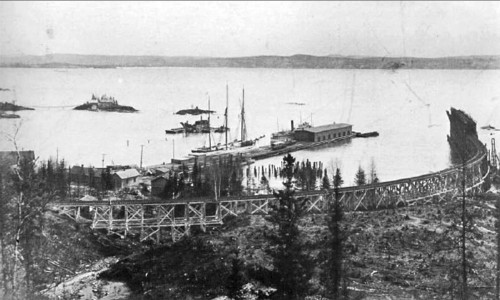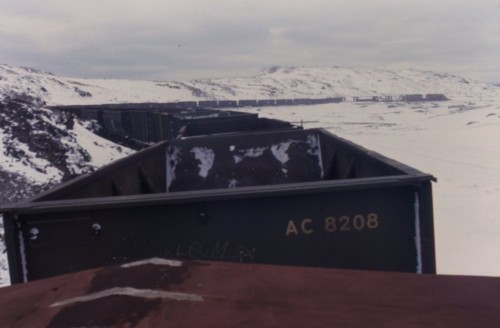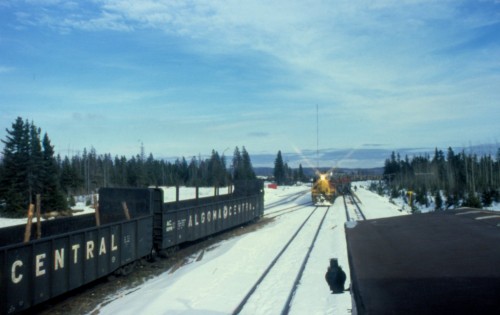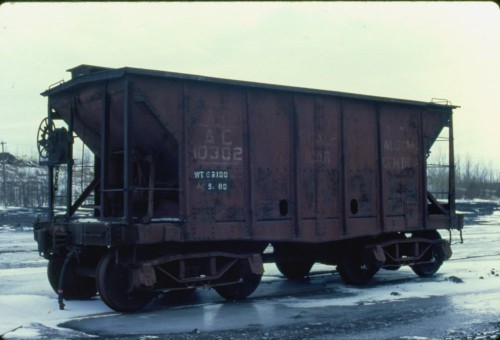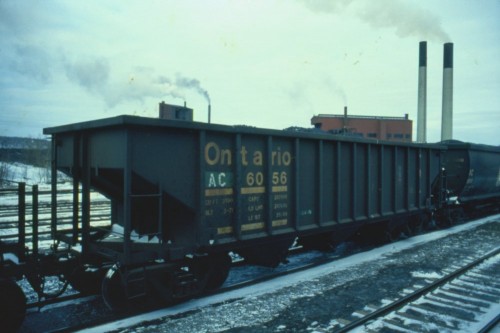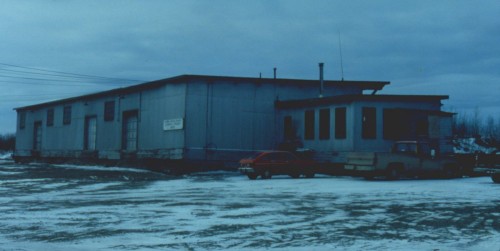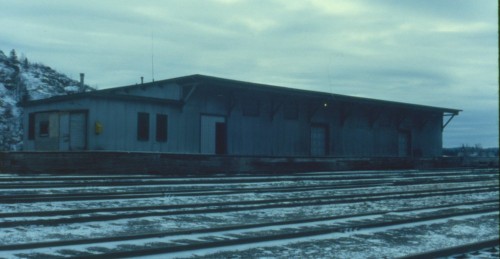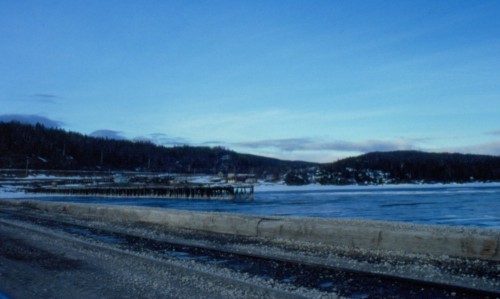Tag Archives: Michipicoten
Iron ore and coal traffic on the Michipicoten subdivision
In the late 1890s industrialist Francis Clergue was building his business empire in Sault Ste. Marie when in 1898 a prospector brought a lump of ore to the attention of Clergue’s company and the rest, as they say, is history – albeit one with its share of bumps and bruises along the way and not necessarily a happy ending.
Early Years
In response to the ore discovery, in 1899 Clergue chartered the Algoma Central Railway and built a twelve mile line from a harbour at Michipicoten to the newly established Helen mine, a few miles northeast of what is today Wawa. Another mine (Josephine) was established a couple years later several miles further east. The harbour at Michipicoten featured a large 275′ wooden ore dock with a 600 ton capacity and a long curving approach trestle, as well as a 600′ commercial pier with a large warehouse and passenger station. Steel ore cars built in 1899-1901 were acquired new from the Pressed Steel Car Co. in Pennsylvania.
Within a few years however, cracks began to appear in the ACR’s parent company, the Lake Superior Corporation, and in 1903 Clergue’s empire suffered a spectacular financial crash. Most iron mining activities came to a stop and Helen mine was abandoned. Not much happened on the Algoma Central for the next several years, with the railway and other various companies in the Lake Superior Corporation family entering a slow period until about 1909.
In 1909-1910, fortunes took a turn for the better. Construction was restarted on the main line from where it had been abandoned in 1903 some 70 miles north of the Sault, and by 1914 had been completed to Hearst. The line to Josephine mine was rebuilt and extended towards what would become Hawk Junction, and a new 9 mile long spur was built in 1910 from a point between Wawa and Josephine to access the new Magpie mine. The ore at Magpie was lower grade than what was mined at Helen, and extensive ore processing facilities were constructed at the mine to upgrade the ore. While Josephine mine seems to have never truly amounted to much, Magpie mine was a strong source of traffic for several years and additional steel ore cars were purchased secondhand from the Duluth & Iron Range Railway in 1916. Also in 1910, an pyrite mine was established by Madoc Mining near Goudreau, north of Hawk Junction with product shipped to the harbour at Michipicoten – mainly in wooden ore hoppers assigned to this service.
Ultimately however, Magpie shut down in 1921 bringing an end to iron mining in the Wawa region once again, and in about 1925 the pyrites operation at Goudreau also shut down. Through the rest of the 1920s the railway would be sustained by pulpwood revenues.
Coal and Fuel
In 1929 the remains of the abandoned ore dock were removed and replaced by a large coal dock with a travelling unloading bridge structure to unload coal from bulk freighters. The majority of the coal brought in to the port would be loaded in CN cars to be shipped to various northern Ontario terminals for locomotive fuel. This traffic would keep the port quite busy and in 1943 the dock was significantly expanded.
Dieselization during the 1950s was the death knell for coal being handled via this port, and the traffic declined throughout this decade, eventually ending some time in the 1960s at which point the coal handling equipment was removed. A small Imperial Oil tank farm was built at the habour in the early 1950s to bring in diesel fuel via tanker vessel which maintained some fuel traffic, but a few tank cars was a far cry from train loads (literally) of coal.
The Return of Iron Mining
In the late 1930s, Algoma Steel began an aggressive expansion and bold moves were made to redevelop the mines in the Wawa area. In 1939, nearly 20 years since that last ore had previously been mined in the area, the mine at Helen was redeveloped and a new ore processing plant was constructed at Wawa. Raw ore was shipped from the mine(s) to the sinter plant, and the processed ore was shipped either by rail to Sault Ste. Marie or to Michipicoten harbour where a large new unloading trestle and loading equipment were built to load ore into lake freighters. Large numbers of steel hoppers were acquired secondhand from various roads in the United States, the railway’s old fleet of 1900-built ore cars being long gone, and would have been massively obsolete anyway by then.
Then in that same year Hitler’s Germany invaded Poland, and suddenly a resource hauling railway serving a steel mill became a rather hot property indeed. (It’s entirely possible that the politically savvy head of the Algoma Steel Company, Sir James Dunn, may have anticipated the conflict in attempting to redevelop the Wawa mining industry from 1937-39.) The boost that the wartime revenues gave the railway carried through after the end of the conflict with the railway continuing strong through the 1950s and 1960s. In the early 1960s the principal amount on the construction bonds to build the railway was finally paid off and the company paid a dividend to shareholders for the first time in its entire history.
During the early 1940s an attempt was made to redevelop the old Josephine mine as well, with work begun in 1941 on draining a lake and sinking new underground mine shafts. Ore began shipping out of the mine in 1945, unfortunately soon after a collapse of large section of the mine brought a final, permanent end to the works at Josephine. Other mines were developed though, such as the open pit Sir James mine, reached via the three and a half mile Siderite spur and operating through the 1950s.
During the 1950s facilities at the Helen mine were significantly upgraded, with a new underground mine shaft being developed at the site (The George A. MacLeod mine). A bucket tramline had been built in the 1940s or early 1950s to carry raw ore from the mine to Wawa and this was replaced later with a high capacity conveyor system that brought the ore directly from the underground MacLeod mine to the sinter plant. The unloading trestle at Michipicoten harbour was also upgraded in the 1950s to a conveyor system from a dumping pit for the railcars.
An indication of the importance of the facilities at Michipicoten during the 1950s is that the railway built new diesel locomotive servicing facilites at Brient (the yard for the harbour, just under a mile up the hill), although by the 1970s ore was shipped to Algoma Steel entirely by rail year-round, and the ore handling facilities, as well as the coal dock, the old commercial dock (as pulpwood shipments also switched to an all-rail basis in the late 1950s) and the Brient yard were all abandoned. (The old ore trestle doesn’t seem to have been actually demolished until the late 1980s.)
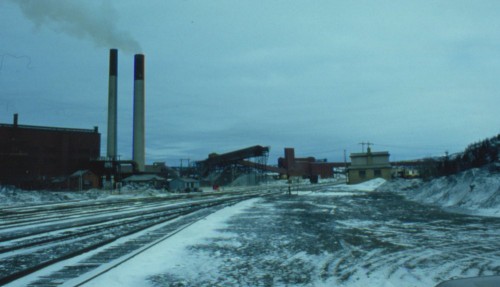
March 1981 view of Wawa yard. The main sintering facilities are to the left. The structures in the centre of the photo are part of the conveyor system that delivers ore from the mine to the plant, and the buff coloured building at right is the ACR station. Photographer unknown, slide in my collection.
In the early 1970s however, some new traffic began using the former coal dock at Michipicoten: limestone, deposited by self-unloading vessels, would be shipped to Wawa for blending with the sinter. Coke and even some additional grades of iron ore for blending with the Wawa ore were also handled via Michipicoten harbour through the 1980s and 1990s.
During the late 1990s however, Algoma Steel began switching over to using higher grades of iron ore mined in the Michigan Upper Penninsula, and in 1998 the mine and sinter plant at Wawa closed down, bringing a final? end to iron ore mining in the area, at least for now. With the sole source of traffic on the branch eliminated, the railway filed for abandonment of the line, and in 2000 the tracks from Hawk Junction to Michipicoten were removed.
Notes on an old Slide Collection III: Michipicoten Branch
A few more from the collection. This batch is all related to the Michipicoten subdivision branchline west of Hawk Junction.
The Michipicoten branch runs 26 miles from Hawk Junction west to Wawa and the harbour on Lake Superior at Michipicoten. Primarily serving the Algoma Ore Properties (a subsidiary of Algoma Steel) iron mines and sinter plant at Wawa, this line was the domain of the ore trains.
An empty ore train westbound between Hawk Junction and Wawa. East of Wawa there is a significant area where the landscape has been ravaged by the fallout of nearly a century of iron ore processing in the area. Those familiar with north-central Ontario will be aware of the similar treeless blackened landscape that made the Sudbury region [in]famous before INCO built the “super-stack” there to disperse (and thereby dilute) emissions over a larger area, and a concerted environmental remediation program was undertaken.
Here we see the ore train snaking through the rocky terrain of the treeless zone. The winter contrast of white snow against the black rocks only increases the starkness of the scene. I guess on the plus side, you get a pretty good view of the entire train, which isn’t very common on the remote lines twisting their way through the northern Ontario forests.
Look closely and note in particular the first four cars of the train – not ore hoppers but empty flatcars and a gondola for pulpwood loading at a log spur west of Wawa.
This location can be deduced to be Trembley, a siding approximately 3-4 miles west of Wawa. The timetable additionally lists two loading spurs at Trembley, one operated by Abitibi Paper (later St. Marys Paper) and the other by Newaygo Forest Products (a company that also had significant operations at Mosher and Mead on the Northern Subdivision).
Close inspection of the photo shows one of the spurs curving off far in the background to the left of the engines of the train. Based on the sequence of slides in this batch, and also comparing the layout to the traces left behind and visible on overhead satellite imagery, this photo is taken at the east end of Trembley siding from the caboose of the same train as the ore train seen above. The train is westbound to Michipicoten harbour and standing on the main track at Trembley. The engines visible in this photo are NOT from the same train however. Close inspection of both photos shows a pair of SD40 type locomotives on the head of the ore train, and there are at least 3 GP7 locomotives on the pulpwood extra seen here. (Note that timetables through the 1970s and ’80s did not list any regular trains on the branch, and all trains were run as extras.)
While the above photo at first glance may appear to show an arriving train pulling into the siding, there are a number of things that don’t make sense about that, not the least of which is that it appears to be showing a *loaded* train of pulpwood arriving from the east, and pulpwood loads should be heading back in that direction. Clearly this train was likely already here and waiting in the siding for the arrival of “our” train and has resumed actively switching the Abitibi spur in the distance, while our train has stopped on the main track to set off those 4 empty cars for pulpwood loading seen at the front of the train in the first photograph.
The branch is mostly known for the ore related traffic, and solid trains of hoppers, but this photo really shows the scale of pulpwood operations here; clearly there was enough traffic to be running both a pulpwood extra and an ore extra (which also had 4 more empty cars to drop off for pulpwood loading!) The 1978 Time Table lists car capacities of the Abitibi and Newaygo spurs at Trembley at 45 and 24 cars, respectively (at 50′ per car), and in addition to the 44 car passing siding, instead of a car capacity in the house track column is the notation “Yard”, suggesting the presence of perhaps two or more side tracks for car storage in addition to the identified customer spurs. This definitely expands the operational possibilities on the branch line, and for pulpwood loads in general.
Wawa. The primary raison d’être of the Michipicoten branch of the Algoma Central Railway was to serve the iron mining of the Wawa area. The mining industry in the area has had a rocky history, with various operations stopping and re-starting in the early part of the 20th century.
From its incorporation in 1899, the Algoma Central was built to move iron ore from a large deposit discovered near Wawa to a harbour built at Michipicoten Bay on Lake Superior. The harbour featured a elaborate wooden ore dock and a commercial dock where passenger boats called and other ships loaded pulpwood. Ore and pulpwood was shipped south over the lake to the various industrial interests in Sault Ste. Marie. The ACR also (slowly) pushed north from Sault Ste. Marie but the 1903 financial crash of the industrial empire of which the ACR was a part brought things to a halt with construction not beginning again until 1909. It was only in 1912 that the main line reached what is now Hawk Junction and connected Wawa to the Sault directly.
The first iron ore sintering plant at Wawa was built in 1939, and was significantly expanded several times over the next 50 years. By the 1980s, ore from the MacLeod Mine (a 2000 foot deep underground mine located adjacent to the site of the original 1899 Helen open pit mine) was delivered directly to the sinter plant via the world’s tallest single-lift conveyor belt. Here the ore was heated and blended with additives such as limestone and other ore fines brought in through the harbour at Michipicoten to upgrade the ore for the Algoma Steel blast furnaces at Sault Ste. Marie. In 1998 however, the Algoma Ore operations around Wawa were shut down, with the steel mill sourcing taconite ores from south of the border, and the sinter plant was eventually torn down. Absolutely nothing in the above photo save for the rocky terrain itself still exists today.
This scale test car photographed at Wawa was converted from one of the first steel hopper cars rostered by the Algoma Central. These cars were built by the Pressed Steel Car Company in 1900-1901, meaning this car was somewhere around its 80th birthday when photographed in the winter of 1980-81. Amazingly this car actually still exists today; it’s preserved at the Canadian Railway Museum in Delson, Quebec.
From the oldest to the newest. Built in 1971 by National Steel Car for the Ontario Northland Railway, these are actually older than the 8201-8500 series rapid-discharge cars acquired new in 1974-75, but these 30 cars acquired secondhand from the ONR in 1978 were the last hoppers acquired by the Algoma Central Railway before they were absorbed by the Wisconsin Central in 1995. For several years they kept their old Ontario Northland numbers with the reporting marks re-stencilled “AC”, but around 1986 these cars were renumbered into a proper AC number series, AC 8600-8629. A check of the UMLER (computerized equipment register) shows that many of these cars are actually still in service, making them the last surviving hopper cars in AC markings.
Express freight shed at Wawa. Front and back sides. This is pure gold for being able to model this structure. While much larger, some similarities in construction can be seen between the Wawa shed and the smaller shed at Hawk Junction, seen in the previous post.
And finally, on the frozen shores of Lake Superior at Michipicoten harbour. This photo is taken from the modern dock at Michipicoten, which was built as a coal dock in 1929 (and extended in size several times over the years) to replace the original ore dock. From the 1920s to the 1960s, this was a port to bring in coal to fuel northern Ontario paper mills and also for CNR locomotive coal for northern terminals. In 1939 when the sinter plant was constructed at Wawa, an ore unloading bridge was added to tranship ore from rail to ship. It’s too bad there were no slides that showed the opposite direction, looking towards the old facilities on the coal dock – a video I have from the late 1980s shows that some remnants of the old steel work was abandoned but actually still standing at this time. By the 1980s all of the previous operations at Michipicoten had been abandoned but the dock continued to see significant traffic. Self-unloading ships depositing huge stockpiles of limestone, coke and other ore fines on the dock, and these were loaded into hoppers using large front-end loaders and shipped as required to Wawa to support the operations of the sinter plant there.
The old rotting wooden dock visible in the above photo is the remains of the original commercial dock, abandoned some time in the late 1950s or early 1960s


